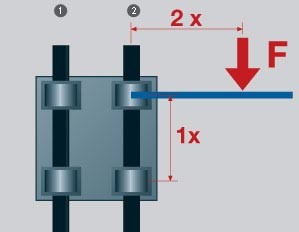Linear Bearing: symptoms versus solutions
Occasionally our customers experience seizing or irregular motion when using plain bearings for linear applications. There is usually a simple solution to hand.
Below are examples of installation anomalies that may cause linear plain bearings to bind and chatter, as well as the symptoms and solutions for each problem.
The bearings are not spaced far enough apart relative to the cantilevered load or drive force
Symptom: the bearings judder as they slide in one or both directions of travel when carrying a cantilevered load. The other scenario is that the bearings do not move at all when moved by an offset drive force.

Solution: firstly, increase the centre-to-centre distances of the bearings along one rail and in the same direction as the axis of travel. It is essential to make sure that the igus®’ drylin® Expert System has been used to determine if the bearings are properly spaced for the application, and also to make sure that the correct system has been designed into the application.
Secondly, ensure that one side of the system boasts “fixed” bearings and the other “floating”. This is imperative to ensure that the floating side allows for misalignment. igus® promotes the 2:1 rule, the distance between the driving force point and the fixed bearings cannot be more than twice the bearing spacing. Failure to observe the 2:1 rule during the use of linear plain bearings can result in uneven motion or even blocked movement. Often these situations can be remedied with relatively simple modifications.
The bearings are mounted to a surface that is not flat or the rails and/or bearings are not aligned correctly
Symptom: the linear bearing system is binding in certain areas of travel or on certain areas of the rails.
Solution: if the tolerances cannot be improved, use bearings that “float” in the direction of the error. Alternatively, use a linear guide system, like igus®’ drylin W which minimises assembly tolerances. Make sure the bearings or carriages are properly aligned. Avoid over-torqueing the bearing’s guide rails into plastic or aluminium extrusions because it may cause the carriage to bind in those areas.

A spray-on lubricant or grease was applied to the bearings
Symptom: the linear bearing system ran smoothly for several cycles, but after a number of cycles, friction has increased.
Solution: polymer bearings are a great alternative to metal ball bearings since they are dry-running and do not require external lubrication. igus®’ line of polymer bearings, are homogeneous which includes a solid lubricant to ensure low friction performance. Most lubricants that contain propellants might absorb dirt and become more viscous over time, which can cause more friction when used with a polymer bearing.
The load is too heavy for a hand-powered application

Symptom: the system cannot be pushed by hand even though the 2:1 rule was followed. Bearings that slide have a higher coefficient of friction compared to bearings that roll.
Solution: if you want to move the system by hand but avoid the maintenance and higher costs that come along with using ball bearings, a hybrid bearing that both rolls and slides is an ideal solution. Alternatively, it might be worth considering a motor driven system if driving it by hand isn’t plausible as it is outside the parameter constraints.
With the various calculation tools to help specify the right system, it should prevent as many issues as possible but there will always be scenarios outside of the norm. Please let igus® know if we can help.
If you have more questions about linear bearing or systems, read our FAQ section here.



